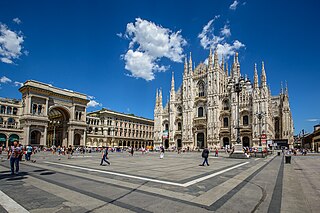
The Galleria Vittorio Emanuele II is Italy's oldest active shopping gallery and a major landmark of Milan. Housed within a four-story double arcade in the centre of town, the Galleria is named after Victor Emmanuel II, the first king of the Kingdom of Italy. It was designed in 1861 and built by architect Giuseppe Mengoni between 1865 and 1877.

The Milan Metro is the rapid transit system serving Milan, Italy, operated by Azienda Trasporti Milanesi. The network consists of 5 lines with a total network length of 111.8 kilometres (69.5 mi), and a total of 125 stations, mostly underground. It has a daily ridership of about 1.4 million on weekdays. The Milan Metro is the largest rapid transit system in Italy in terms of length, number of stations and ridership; and the fifth longest in the European Union and the eighth in the Europe.

The Italian city of Milan is one of the international tourism destinations, appearing among the forty most visited cities in the world, ranking second in Italy after Rome, fifth in Europe and sixteenth in the world. One source has 56% of international visitors to Milan are from Europe, 44% of the city's tourists are Italian, and 56% are from abroad. The most important European Union markets are the United Kingdom (16%), Germany (9%) and France (6%). Most of the visitors who come from the United States to the city go on business matters, while Chinese and Japanese tourists mainly take up the leisure segment.

Via della Spiga is one of the Italian city of Milan's top shopping streets, forming the north-east boundary of the luxurious Quadrilatero della Moda, along with Via Monte Napoleone, Via Manzoni, Via Sant'Andrea and Corso Venezia.

Villas and palaces in Milan are used to indicate public and private buildings in Milan of particular artistic and architectural value. Milan has always been an important centre with regard to the construction of historical villas and palaces, ranging from the Romanesque to the neo-Gothic, from Baroque to Rococo.

Porta Venezia is one of the historical gates of the city of Milan, Italy. In its present form, the gate dates back to the 19th century; nevertheless, its origins can be traced back to the medieval and even the Roman walls of the city.
Porta Monforte is a district ("quartiere") of Milan, Italy, located within the Zone 3 administrative division. It is named after the eponymous city gate, which was added in the 1890s to the existing Spanish walls of the city. The gate was meant to serve as a customs office; the tax booths were designed by Luigi Tormenti and completed in 1889. While the addition of the Monforte city gate was intended to absorb part of the traffic going through Porta Venezia and Porta Vittoria, Porta Monforte remained a minor gate. The gate itself has since been demolished; it was located in what is now Piazza del Tricolore.
Ghisolfa is a district ("quartiere") of Milan, Italy, part of the Zone 8 administrative division of the city, located north-west of the city centre. It is named after the "Ghisolfa Bridge" overpass, part of the external Circonvallazione ring road enclosing the centre of Milan. In turn, the bridge was named after two cascine, "Cascina Ghisolfa" and "Cascina Ghisolfetta", that existed in the area before the urbanization of the mid 20th century. The bridge was completed in 1941, prolonged in the 1960s, and enlarged in the 1990s.

The Milan tramway network is part of the public transport network of Milan, Italy, operated by Azienda Trasporti Milanesi (ATM).

The Zone 1 of Milan, since 2016 officially Municipality 1 of Milan, is one of the 9 administrative divisions of Milan, Italy.

Giardini Pubblici Indro Montanelli, formerly known as Giardini Pubblici and Giardini di Porta Venezia are a major and historic city park in Milan, Italy, located in the Porta Venezia district, north-east of the city center, in the Zone 1 administrative division. Established in 1784, they are the oldest city park in Milan. After their establishment, the Gardens have been repeatedly enlarged (to the current overall area of 172,000 square metres and enriched with notable buildings, most notably the Natural History Museum and the Planetarium.

The Zone 3 of Milan, since 2016 officially Municipality 3 of Milan, is one of the 9 administrative divisions of Milan, Italy.

The Zone 5 of Milan, since 2016 officially Municipality 5 of Milan, is one of the 9 administrative divisions of Milan, Italy.

The Zone 6 of Milan, since 2016 officially Municipality 6 of Milan, is one of the 9 administrative divisions of Milan, Italy.

The Zone 9 of Milan, since 2016 officially Municipality 9 of Milan, is one of the 9 administrative divisions of Milan, Italy.

Piero Portaluppi was an Italian architect. He is known for his prolific output, having designed over 100 buildings in Milan.

Eugenio Gerli was an Italian architect and designer. In an intense working life spanning more than six decades, Eugenio Gerli explored many different areas of his profession. He built villas, apartment blocks, office blocks, factories, banks and stores, and also restored historic buildings. He often completed his works with custom-made interiors and furniture.This diverse range of projects inspired his industrial design and today many have become icons, like the S83 chair, the PS 142 armchair Clamis, the Jamaica cabinet and the Graphis System.

Eugenio Soncini was an Italian architect.
The Library of the Civic Museum of Natural History of Milan was founded together with the Museum in 1838 and it took the collections of Georg Jan and Giuseppe De Cristoforis, and it's the biggest library on natural sciences in Italy.

Ulrico Hoepli, born Johannes Ulrich Höpli, was a Swiss-Italian publisher.



















